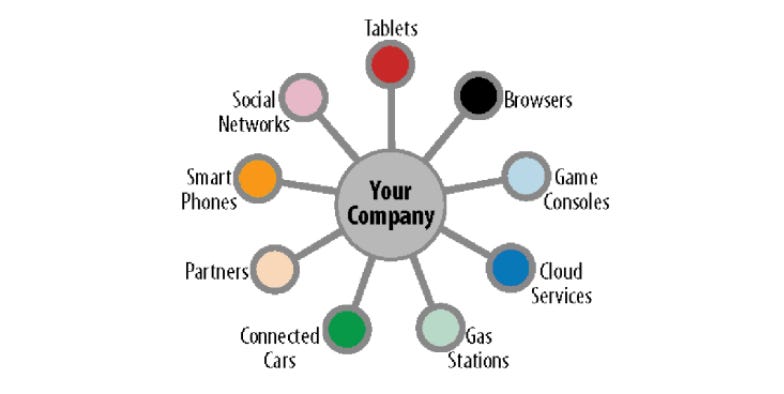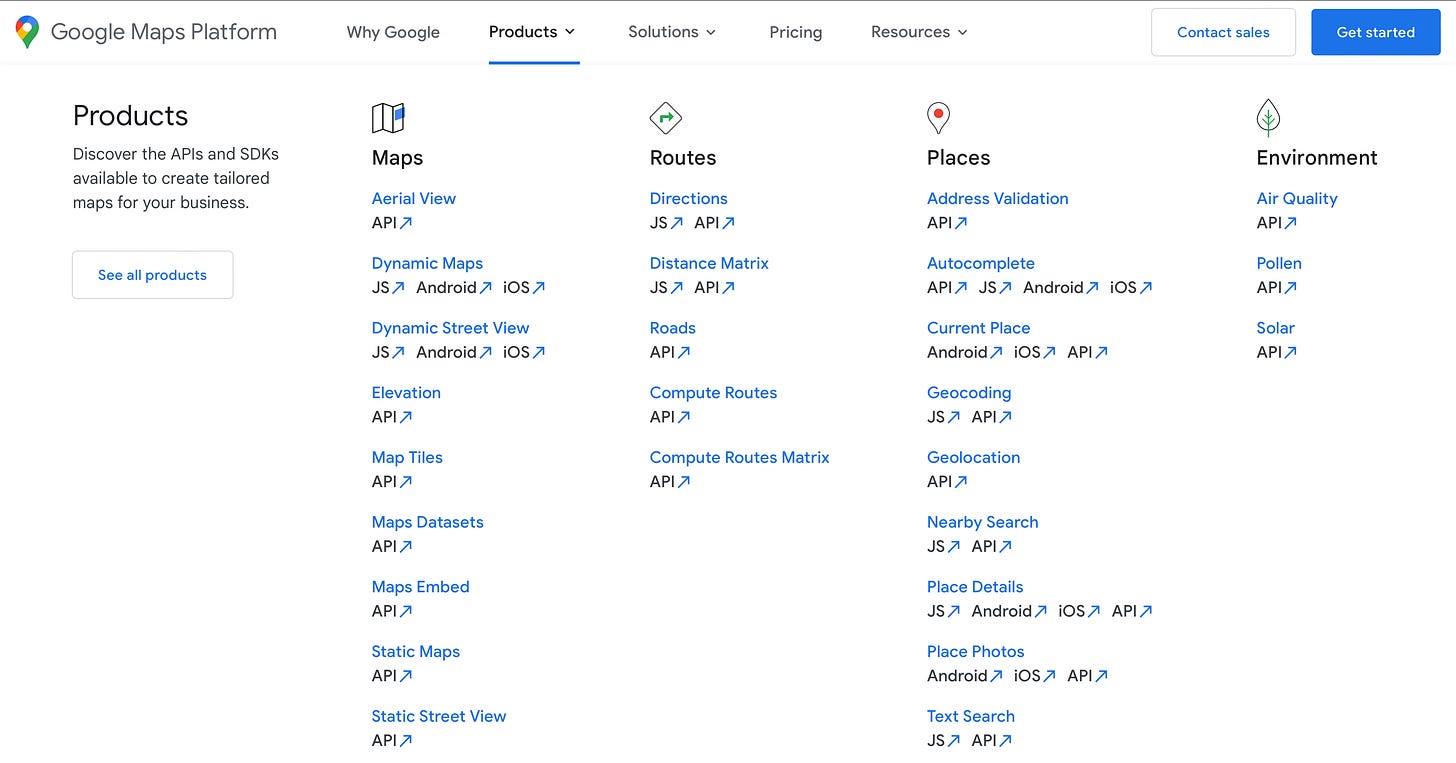How to make your data work for you to drive massive growth
And: why inverting your business is crucial to taking full advantage of the digital economy
the skinny
Companies that monetize their data through a public API increase their market value 12.9% more than their peers after only two years. On average, this excess growth represents a 500× (= 50,000%) return on implementation costs. The gap between API-adopting companies and their peers widens by an additional 38.7% over the next 16 years as the APIs become vital pieces of broader data ecosystems. These effects aren’t limited to technology companies, either; businesses in any sector, of any size, and of any age were shown to experience identical benefits. [Source]

what is an API?
An API (or Application Programming Interface) is a documented gateway that gives programmers the ability to securely interact with your data. APIs can be either private or public. Private APIs are by far the more common flavor, and they are used by most companies with a digital presence. These APIs are purely internal, accessed by employees and contractual partners in a carefully prescribed way. This type of API powers most modern websites and mobile apps. Public APIs, on the other hand, are open to almost anyone who agrees to the terms of use: individuals, start-ups, and even competitors. Of course, these APIs usually come at a price, but many are willing to pay it.
how do you make a product out of that?
Before going any further, let’s clarify: if you want others to see your API as a product, you need to treat it like one. This sounds like common sense, but this point cannot be overstated, especially because the quality of an API is not immediately obvious to those who are not developers. When developing a normal website, even non-technical stakeholders can witness slow load times and design defects firsthand; when building an API, many comparable issues can remain hidden. This has dire consequences for the eventual success of the API. Your business needs to approach your public API(s) with the same data-driven product thinking as your other offerings.
More specifically, though, there are three key characteristics that distinguish the most successful public APIs from the rest. These are:
security and reliability
high discoverability
logical structure
The security and reliability of your API is absolutely critical. These features minimize the risks involved for both your business and the customers that rely on your data, allowing your API to be smoothly integrated into an external data ecosystem (more on that later). Since these two aspects are ubiquitous to all good APIs, they are easy to take for granted, but they are certainly not guaranteed. Experienced developers routinely produce vulnerable APIs due to cognitive blindspots, and data breaches are the most salient danger of public APIs. Overlooking your implementation’s security and reliability can have disastrous consequences, so make these features the foundation of your API.
High discoverability implies that your API is advertised and search-engine optimized the same as any other product. Again, APIs are not as visible as other digital products, so it will require more effort to elucidate to potential customers the data you offer and the ways it can benefit them. Additionally, the best APIs are thoroughly documented and fully self-service, so that customers can intuitively learn to use and build on your product without any hand-holding. Without high discoverability, acquiring API customers is nearly impossible.
A logical structure improves the customer experience, keeping your customers coming back and opening the door to more serious customers. Without going into too much detail, you might not want to send all the data you can through one API. If necessary, logically divide your data across a few APIs, separated by the type of data they provide. Google Maps is a pristine example of this:
For those who are interested, Zhamak Dehghani has written some fantastic guides on why monolithic data lakes are bad and how to shift to a data mesh instead.
but why are public APIs so valuable?
As the expression goes, data is the new oil. Like oil, data is costly to obtain and difficult to refine, but it has a myriad of potential uses. Continuing the analogy, public APIs are the pipelines that transport the oil. On the surface, it might look risky for a company to simply hand away its most valuable and unique resource like this, even for a fee. After all, in the foundational resource-based view, exposing hard-earned data is needlessly setting fire to a sustainable competitive advantage.
This is not the case, however, because of data’s unparalleled value density. For instance, a relatively small spring of meteorological data could serve as the basis for a weather app, a complex forecasting system, a source for climate research, and much more. Data is too rich for a single organization to fully capitalize on. Wouldn’t you let others deal with the use-cases you can’t, to your benefit?
Even more simply, there are too many different types of connected devices for a single organization to build for all of them. Wouldn’t you let others build for the devices you can’t, also to your benefit?

how does this lead to growth?
Data perfectly aligns with the rationale behind the “inverted firm,” or a platform business model. Platforms are inside-out businesses; they’re designed to boost value creation outside the organization, not within. Not all platforms work with data — Airbnb, for example, works with short-term-rentable spaces. The hosts on Airbnb can be seen as the producers of lodging opportunities, which are consumed by guests. Unlike a hotel, Airbnb doesn’t own and develop its own properties. Yet, simply through connecting hosts and guests, it has fostered a flourishing hosting ecosystem. [Source]
(Substack is also a platform business. It connects writers with readers, with the ultimate goal of creating a larger pool of quality content than any traditional media company could. Furthermore, readers can get even more value by reading several publications which together enable a more complete perspective. This is why, if you enjoy Substacks like How They Grow, Market Sentiment, or Business Brainstorms, you should also be subscribed to Perspicua. ☺️)
A business that inverts itself is, in some sense, undergoing intentional vertical disintegration. In the end, it will contribute a smaller share of the value of the final product. However, the audience for that final product expands so remarkably as a result that this apparent flaw is far outweighed. Platforms are the network effect turned into a full-fledged business model. For this reason, platforms struggle in conventional value chains; instead, platforms join (or establish) an organic, non-linear value network.
Rather than flowing in a straight line from producers to consumers, value may be created, changed, exchanged, and consumed in a variety of ways and places, all made possible by the connections that the platform facilitates.
Data-centric platforms are one form of inverted business. Similar to other types of platform businesses, the value of this type of platform comes from the connections made by outside parties. Compared to the substrates of other value networks, though, data has even more potential for synergistic combinations.
For a contrived illustration of this fact, take our meteorological data source from before and meld it with a social data source (e.g. X or Instagram). In conjunction, these two sources have more uses than either one on its own. A social event planning app that proposes ideas for specific weather conditions, perhaps, or a tool to assess the impact of weather events on a community’s mood and behavior. Without either of the data sources changing, the value of both increased by knitting them together.
In this way, each player in a data ecosystem complements — and is complemented by — the other players. In the real world, the connections that can be made from a handful of data sources can be downright revolutionary. Public APIs are the way for a business to integrate itself into these rewarding data ecosystems. And since reusing data is effectively free, a public API has the capacity to be joined with a near-infinite number of other APIs.
the wrap-up
No business today can get by without data, but much of the potential for that data is ignored due to outdated ideas about competitiveness. In reality, there are huge prospects for companies that approach their data as a product, because they will be able to participate in the blossoming data ecosystems that are driving the future of the digital economy.
The earliest entrants to a data ecosystem become the most central characters as it develops. Your business can be one of them if you start now on monetizing your data through a secure, reliable, discoverable, and logically structured public API. Don’t let your data go to waste.



